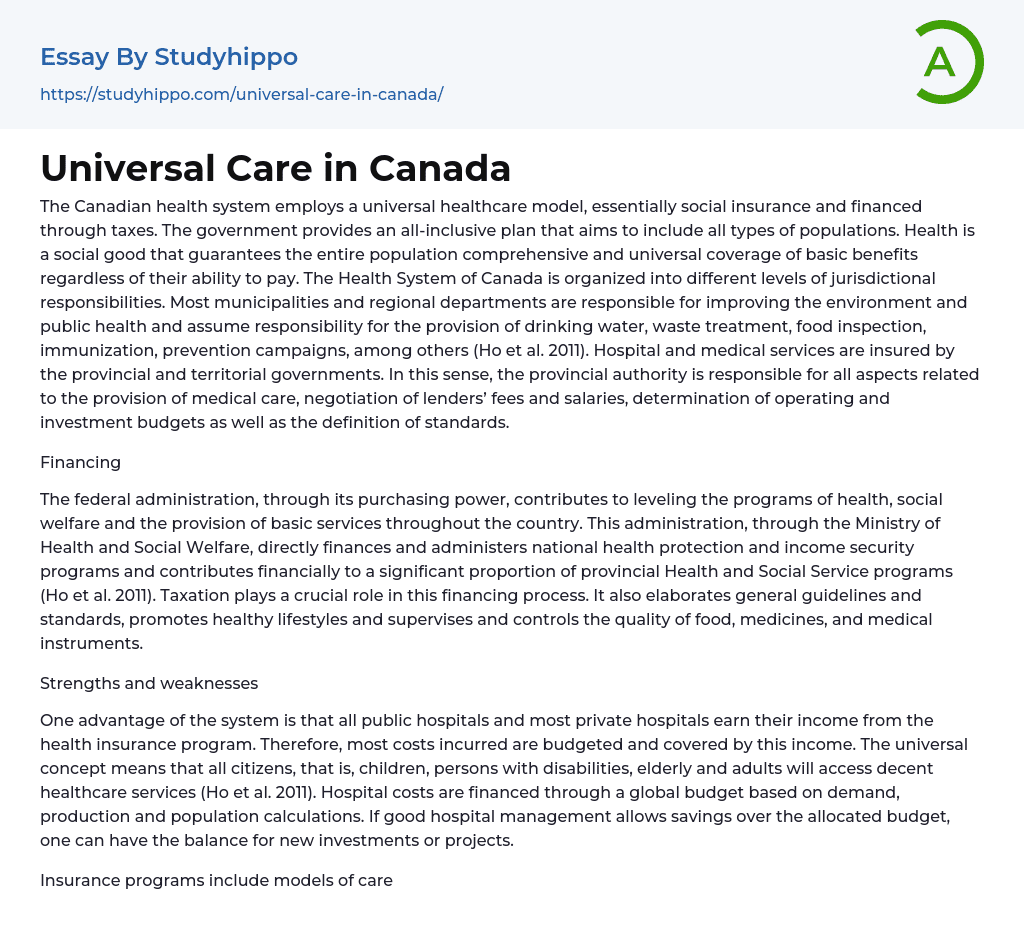The Canadian healthcare system is based on a model of universal healthcare, which is funded through taxes and operates as social insurance.
The government's goal is to provide a healthcare plan that ensures universal and inclusive access to all individuals, regardless of their financial status. This plan guarantees essential benefits for every citizen.
In Canada, the Health System is divided into various levels of jurisdictional responsibilities. Municipalities and regional departments primarily focus on enhancing public health by improving the environment, providing clean drinking water, managing waste, inspecting food, conducting immunization and prevention campaigns, among other duties (Ho et al.).
In terms of hospital and medical services, they are insured by the provincial and territorial governments, with the provincial authority responsible for various aspects such as medical care provision, negotiation of fees and salaries for lenders, determining budgets for operations and investments,
...and setting standards.
Financing
The federal administration plays a role in ensuring equal access to health programs, social welfare, and basic services across the country. Specifically, the Ministry of Health and Social Welfare directly provides funding and manages national health protection and income security programs. Additionally, it contributes financially to a significant portion of provincial Health and Social Service programs (Ho et al., 2011).
Taxation is crucial in the financing process (2011) and also serves to establish standards, guidelines, and regulations for the quality of food, medicines, and medical equipment while promoting healthy lifestyles.
Advantages and disadvantages
An advantage of this system is that both public and private hospitals benefit financially from the health insurance program, which helps cover a significant portion of expenses.
The idea of universality guarantees that all individuals, regardless of age or ability,
will have equal access to excellent healthcare services (Ho et al., 2011). Hospital funding is determined by a global budget that takes into account demand, production, and population estimates. Effective hospital management allows for savings within the budget, which can be allocated towards new investments or initiatives.
Insurance programs implement care models that involve auditing induced consumption. If excessive invoicing is found, penalties, suspension of enrollment, or discounts may be applied (Lasser et al. 2006). Despite offering comprehensive coverage, the Canadian system lacks efficiency due to significant wait times for non-emergency services. These extended waiting periods pose serious risks to patients as their conditions may worsen while awaiting treatment. Additionally, referrals can further compromise patients' healthcare.
Could this system be viable in the United States?
The United States does not currently have a tax-funded universal health system, unlike most countries. However, Canada's healthcare system provides valuable insights for the US to examine. In contrast to the expensive private healthcare system in the US with advanced technology, its overall population health is lower than that of other industrialized nations (Lasser et al. 2006). Nonetheless, implementing a universal approach similar to Canada's and funding it through taxes may potentially make it more affordable for majority of Americans.
In the United States, individuals who are extremely poor, low-income workers, or have severe health issues face significant challenges in affording even basic healthcare coverage. Unlike Canada's system, where public medical insurance costs are primarily funded through taxes, implementing a similar approach in the United States would enhance the feasibility and affordability of universal healthcare. This would involve allocating a portion of tax revenue towards healthcare.
References
- Lasser, K. E., Himmelstein, D. U., ; Woolhandler, S.
(2006). Access to care, health status, and health disparities in the United States and Canada: results of a cross-national population-based survey. American journal of public health, 96(7), 1300-1307.
C. (2011). In a study published in the Journal of Clinical Oncology, volume 29, issue 12, pages 1587-1591, C. examines the trends in aggressiveness of end-of-life cancer care within Ontario's universal health care system in Canada.




